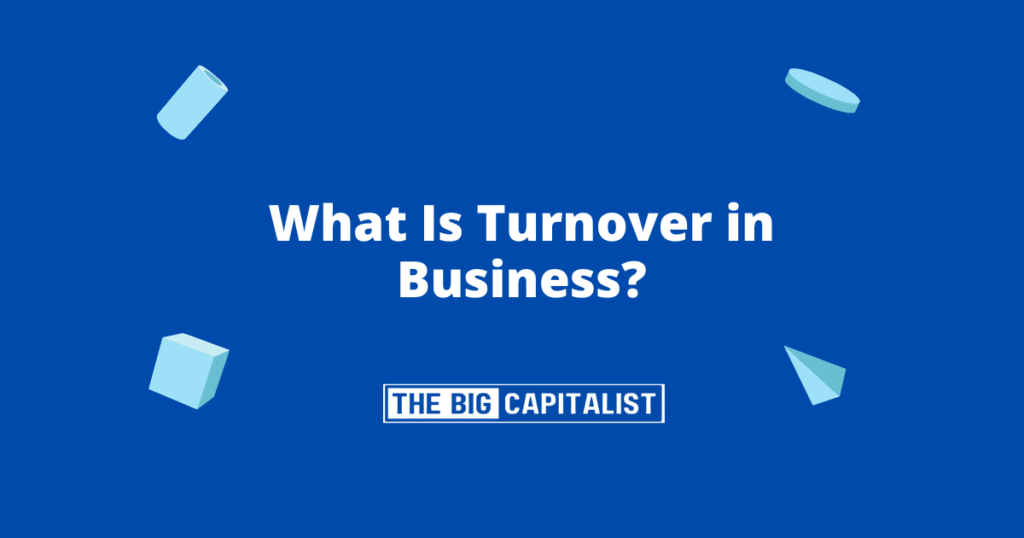In business, the term “turnover” is often used but not always clear. Turnover means the total sales or revenue a company makes in a specific time. It’s a measure of how quickly a company conducts its business operations. While it might sound straightforward, turnover can vary significantly depending on the context and the type of business. For example, a retail business may focus on inventory turnover, while a service-oriented business might prioritize revenue turnover. Understanding the nuances of turnover helps businesses tailor strategies to optimize their performance and achieve financial goals.
Types of Turnover
There are several types of turnover that businesses must keep an eye on. These include:
- Revenue Turnover: This is the most common understanding of turnover. It represents the total income a business earns from its core operations, typically reflected in the sales of goods or services. Revenue turnover is essential for assessing the market demand and financial health of a business. By tracking revenue turnover, companies can identify trends and adapt their strategies to maximize profitability.
- Inventory Turnover: This indicates how often a company’s inventory is sold and replaced over a period. A higher inventory turnover ratio suggests efficient management and strong sales, while a lower ratio may indicate overstocking or weaker sales. Effective inventory management ensures that a business can meet customer demands without incurring excess holding costs. Companies that maintain an optimal inventory turnover can better align their supply chain operations with market needs.
- Asset Turnover: This measures how efficiently a company uses its assets to generate sales. It’s calculated by dividing total sales by the average assets over a period. High asset turnover indicates that a company is using its resources effectively to generate revenue. Conversely, low asset turnover may reveal potential inefficiencies or underutilized assets that need to be addressed to improve financial performance.
- Employee Turnover: Although slightly different from the financial context, employee turnover refers to the rate at which employees leave a company and are replaced by new staff. High employee turnover can disrupt operations and negatively impact company morale. Understanding the reasons behind employee turnover enables businesses to implement retention strategies and foster a stable, motivated workforce.
Why Is Turnover Important?
Turnover is a vital indicator of business health and efficiency. Understanding turnover can help business owners and managers make informed decisions, improve processes, and ultimately enhance profitability. Businesses that focus on turnover metrics can identify operational strengths and weaknesses, allowing them to allocate resources more effectively. Additionally, turnover insights can guide strategic planning and investment decisions, ensuring long-term success.
Revenue Turnover: A Measure of Success
Revenue turnover is a direct indicator of a company’s success in generating sales. It reflects the effectiveness of marketing strategies, the demand for products or services, and the overall financial health of the business. A consistent increase in revenue turnover suggests growth and stability, while a decline could signal underlying issues that need addressing. Companies can leverage revenue turnover data to refine their market positioning and enhance customer engagement. Additionally, analyzing revenue turnover patterns helps businesses forecast future sales and adjust their strategies accordingly.
Inventory Turnover: Sign of Operational Efficiency
Inventory turnover provides insights into how well a company manages its stock. High inventory turnover implies that a business efficiently matches supply with demand, minimizing carrying costs and reducing the risk of obsolescence. Conversely, low turnover may highlight overstocking, sluggish sales, or ineffective inventory management. By optimizing inventory turnover, businesses can improve cash flow and minimize waste, leading to a more agile and responsive supply chain. Additionally, efficient inventory management contributes to customer satisfaction by ensuring product availability and timely delivery.
Asset Turnover: Gauging Asset Utilization
Asset turnover is a critical metric for assessing how well a company utilizes its assets to generate sales. High asset turnover indicates effective use of resources, while low turnover may point to underutilized or inefficient asset deployment. By optimizing asset turnover, businesses can improve their return on investment and overall profitability. Regular asset evaluations and strategic investments in technology can enhance asset utilization and drive growth. Companies that focus on asset turnover can better align their operations with business objectives, maximizing the value derived from their assets.
Employee Turnover: Impact on Company Culture
Employee turnover, although not directly related to financial turnover, is an important aspect of overall business performance. High employee turnover can lead to increased recruitment and training costs, loss of institutional knowledge, and a negative impact on company culture. By understanding the reasons behind employee turnover, businesses can implement strategies to improve retention and maintain a motivated, skilled workforce. A positive work environment and strong employee engagement contribute to higher productivity and innovation. Businesses that prioritize employee retention can build a strong employer brand, attracting top talent and reducing turnover costs.
Managing Turnover Effectively
To ensure a healthy turnover rate, businesses should adopt strategies tailored to each type of turnover they encounter. Effective turnover management involves continuous monitoring and proactive adjustments to align with changing market conditions. By focusing on turnover metrics, businesses can enhance operational efficiency and drive sustainable growth.
Strategies for Improving Revenue Turnover
- Enhance Marketing Efforts: By refining marketing strategies and targeting the right audience, businesses can boost sales and improve revenue turnover. Tailored marketing campaigns can increase brand awareness and attract new customers, driving sales growth.
- Expand Product or Service Offerings: Introducing new products or services can attract more customers and increase sales. Diversifying offerings allows businesses to capture new market segments and reduce dependency on a single revenue stream.
- Optimize Pricing Strategies: Competitive pricing can drive sales and improve revenue turnover. Regularly reviewing and adjusting pricing strategies ensures that products remain attractive to customers while maintaining profitability.
Boosting Inventory Turnover
- Improve Demand Forecasting: Accurate demand forecasting helps businesses manage inventory levels effectively and avoid overstocking. By leveraging data analytics, companies can predict market trends and adjust inventory levels accordingly.
- Implement Just-in-Time Inventory: By adopting just-in-time inventory practices, companies can reduce carrying costs and improve turnover. This approach minimizes excess inventory and aligns supply with real-time demand, enhancing operational efficiency.
- Streamline Supply Chain Operations: Efficient supply chain management ensures timely restocking and minimizes delays. Collaborating with suppliers and optimizing logistics processes can improve inventory turnover and customer satisfaction.
Enhancing Asset Turnover
- Regular Asset Evaluation: Conduct regular assessments of asset utilization to identify underperforming assets and optimize their use. Understanding asset performance allows businesses to make informed decisions on asset allocation and investment.
- Invest in Technology: Implementing technology solutions can improve operational efficiency and asset turnover. Automation and digital tools can enhance productivity and enable better resource management, maximizing asset utilization.
Reducing Employee Turnover
- Foster a Positive Work Environment: Creating a supportive and inclusive workplace can enhance employee satisfaction and reduce turnover. Encouraging open communication and recognizing employee contributions builds a strong organizational culture.
- Offer Competitive Compensation and Benefits: Competitive pay and benefits packages can attract and retain top talent. Regularly reviewing compensation structures ensures that they remain aligned with industry standards and employee expectations.
- Provide Career Development Opportunities: Offering training and advancement opportunities can increase employee engagement and reduce turnover. Investing in employee growth demonstrates a commitment to their success and fosters loyalty.
Conclusion
Turnover in business is a multifaceted concept that encompasses more than just revenue. By understanding the different types of turnover and their implications, businesses can gain valuable insights into their operations and make informed decisions to improve efficiency and profitability. Whether it’s boosting sales, optimizing inventory, utilizing assets effectively, or reducing employee turnover, managing turnover is essential for long-term business success. Businesses that prioritize turnover management can enhance their competitive advantage and achieve sustainable growth.
Frequently Asked Questions on Turnover in Business
Q1: What is turnover in business?
The total sales or revenue a company generates over a set period, indicating how fast it conducts its core operations.
Q2: What are the main types of turnover?
- Revenue Turnover: Income from goods or services.
- Inventory Turnover: How often stock is sold and replaced.
- Asset Turnover: Sales generated per unit of asset.
- Employee Turnover: Rate at which staff leave and are replaced.
Q3: Why is turnover important?
It reveals operational efficiency, cash‐flow health, and areas needing improvement—vital for strategic planning and competitiveness.
Q4: How do you calculate inventory turnover?
Divide cost of goods sold by average inventory for the period to see how quickly stock moves.
Q5: What does a high asset turnover ratio indicate?
That a company effectively uses its assets to produce sales and maximize return on investments.
Q6: How can a business improve revenue turnover?
By refining marketing, expanding offerings, and optimizing pricing to boost sales volume.
Q7: What strategies reduce employee turnover?
Fostering a positive culture, offering competitive pay and benefits, and providing career development.
Q8: How often should turnover metrics be reviewed?
Regularly—monthly or quarterly—to catch trends early and adjust tactics for sustained efficiency.
















